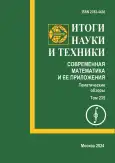Vol 235 (2024)
Articles
On equivalent operators
Abstract
In this paper, we introduce the concept of equivalent operators, i.e., operators with the same invertibility states, and establish their connection with weakly similar and similar operators. We find the invertibility states of some classes of linear operators, in particular, operators with involution and operators with compact resolvent. We discuss approaches to constructing equivalent operators and give examples of equivalent operators.
 3-14
3-14


Hierarchical models in discrete percolation theory and Markov branching processes
Abstract
A brief introduction to percolation theory is given. Within the framework of the discrete percolation theory on infinite graphs, we develop a method for approximating the percolation probability based on the construction of a sequence of infinite graphs of a special type called the hierarchical graphs. The calculation of the percolation probability for graphs of this type is reduced to the analysis of a suitable Markov branching process with discrete time.
 15-33
15-33


An approach to obtaining identities with binomial coefficients and orthogonal polynomials
Abstract
A series of new combinatorial identities with binomial coefficients and orthogonal polynomials is obtained by using a unified approach. These identities contain Hermite polynomials, Legendre polynomials, Chebyshev polynomials of the first and second kind, Gegenbauer polynomials, and Krawtchouk polynomials.
 34-39
34-39


Classical solution of a mixed problem with the Dirichlet and Neumann conditions for a nonlinear biwave equation
Abstract
For a nonlinear biwave equation given in the first quadrant, we consider a mixed problem in which the Cauchy conditions are specified on the spatial half-line, and the Dirichlet and Neumann conditions are specified on the time half-line. The solution is constructed by the method of characteristics in an implicit analytical form as a solution of a certain integro-differential equations. By the method of continuation with respect to a parameter and a priori estimates, the solvability of these equations, the dependence on the initial data, and the smoothness of solutions are examined. For the problem considered, the uniqueness of the solution is proved and the conditions of the existence of classical solution are established. If the matching conditions are not met, then a problem with conjugation conditions is constructed, and if the data is not sufficiently smooth, then a mild solution is constructed.
 40-56
40-56


Applying Laguerre’s functions for approximate calculation of Green’s function of a second-order differential equation
Abstract
We consider the equation ẍ(t) = Ax(t) + f(t), t ∈ . with the matrix coefficient A. This equation has a unique solution x, which is bounded on , for any continuous bounded inhomogeneity f if and only if the spectrum of the matrix A does not intersect the semi-axis = {z ∈ : z ≤ 0}.
In this case, the solution x is defined by the formula
.
We discuss the problem of approximate calculation of Green’s function G(t) using its expansion into Laguerre’s series. The scale parameter τ in Laguerre’s polynomials is chosen to ensure the highest accuracy.
 57-67
57-67


Weingarten equations for surfaces on Helmholtz-type groups
Abstract
In this paper, we study surfaces on three-dimensional Helmholtz-type Lie groups that define the actions of groups of motions of Helmholtz geometries, which are geometries of local maximal mobility. In this paper, we present left-invariant metrics and Levi-Civita connections for these Lie groups, which were found earlier. For surfaces of Helmholtz-type Lie groups, we calculate the spinors that generate them, which satisfy the Dirac and Weingarten equations. We also derive compatibility conditions for the Weingarten equations.
 68-77
68-77


Asymptotic formulas for magnetization and chemical potential of ferromagnetic metals at low temperatures
Abstract
Explicit expressions for the coefficients in the T2-law for the magnetic moment and chemical potential in Stoner’s theory are obtained in the case of an arbitrary electron density of states. A generalization of Stoner’s ferromagnetism criterion is given in terms of spin-polarized electron densities of states. The proof is based on the asymptotic expansion of the integral with the Fermi function, which was previously used for free electrons.
 78-86
78-86


Investigation of periodic solutions of a two-dimensional system of nonlinear ordinary second-order differential equations
Abstract
The problem of a priori estimate and existence of periodic solutions for a two-dimensional system of nonlinear ordinary second-order differential equations is examined. In terms of the properties of the principal nonlinear part, a theorem on a priori estimate of periodic solutions is formulated and proved. Under the conditions of the a priori estimate, a theorem on necessary and sufficient conditions for the existence of periodic solutions is proved.
 87-96
87-96


Solution of one control problem for a dynamical system in partial derivatives
Abstract
For a second-order dynamic system in partial derivatives with three boundary conditions, the problem of constructing control and state functions in analytical form is solved by the cascade decomposition method. Two criteria of complete controllability are obtained. The first criterion is based on the surjectivity property of a certain matrix. The second criterion is identical to the Kalman criterion. A class of functions is identified that determine the analytical form of control and state functions. A method for constructing control and state functions in analytical form is developed.
 97-108
97-108


Uniqueness distributions for holomorphic functions with growth restrictions in the unit disc
Abstract
We establish new uniqueness theorems for holomorphic functions in the unit disc with given subharmonic majorants for the logarithms of the modules of these holomorphic functions. The results are formulated in terms of distributions of zeros for these holomorphic functions and Riesz mass distributions for subharmonic majorants. They are based on the new scale of inequalities for Riesz mass distributions of subharmonic functions on the unit disc under given inequalities between these functions.
 109-120
109-120







